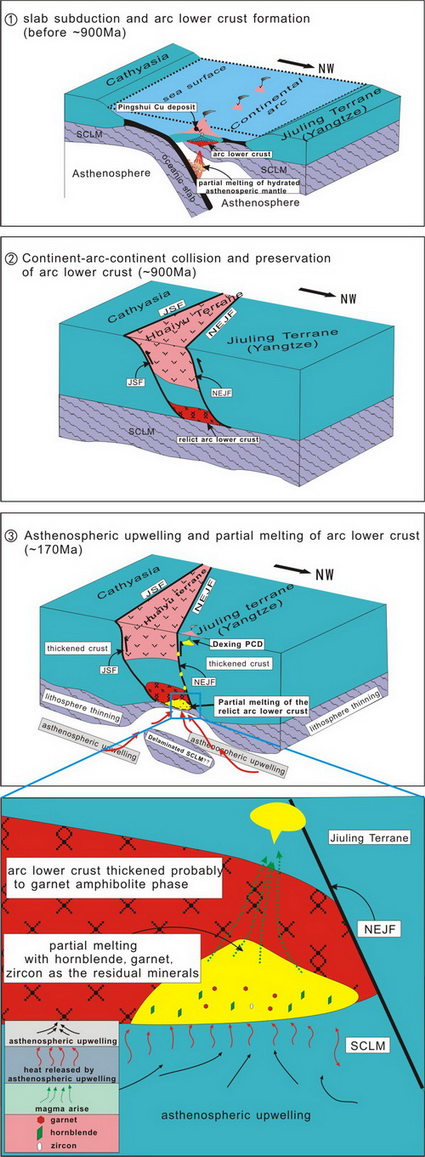Remelting of Neoproterozoic relict volcanic arcs in the Middle Jurassic: Implication for the formation of the Dexing porphyry copper deposit, Southeastern ChinaUpdate time:12 28, 2012
Ph.D. student LIU Xuan and his teacher FAN Hongrui present new results from U-Pb geochronology, whole-rock chemistry and Sr-Nd-Hf-O isotopic investigations on the ore-forming granodioritic porphyry. LA-ICPMS zircon U–Pb data suggest that the granodioritic porphyry was formed in the Middle Jurassic (ca. 172.5 Ma) probably associated with lithospheric thinning driven by either sub-continental lithospheric mantle delamination or asthenospheric upwelling. The porphyry displays both arc-like and adakitic trace element signatures. The adakitic features suggest that HREE (heavy rare earth elements)-rich minerals such as garnet and hornblende, in the absence of plagioclase resided in the source region. The arc-like signatures are broadly comparable with those of the proximal Neoproterozoic island arc rocks including the keratophyre from Shuangxiwu Group and associated granitoids indicating a potential genetic relationship. They propose a new geodynamic model for the Dexing porphyry Cu deposit which envisages that the sulfide-bearing arc lower crustal rocks were generated during oceanic slab subduction in the early Neoproterozoic, the remnants of which were preserved at the crust/mantle boundary. Subsequently, in the Middle Jurassic, these rocks were heated by asthenospheric upwelling and remelted to produce fertile magmas. The magmas ascended along the Northeast Jiangxi Fault and intruded into the Jiuling terrane where Cu precipitation occurred upon subsequent magma cooling and fluid exsolution.
Fig. 1. Schematic model illustrating the various stages to explain the genesis of the Dexing porphyry copper deposit through the melting of the roots of a remnant Neoproterozoic island arc. (Image by LIU) Liu et al. Remelting of Neoproterozoic relict volcanic arcs in the Middle Jurassic: Implication for the formation of the Dexing porphyry copper deposit, Southeastern China. Lithos. 2012, 150: 85-100 (Download Here)
|
Contact
Related Articles
Reference
|
-
SIMSSecondary Ion Mass Spectrometer Laboratory
-
MC-ICPMSMultiple-collector ICPMS Laboratory
-
EM & TEMElectron Microprobe and Transmission Electron Microscope Laboratory
-
SISolid Isotope Laboratory
-
StIStable Isotope Laboratory
-
RMPARock-Mineral Preparation and Analysis
-
AAH40Ar/39Ar & (U-Th)/He Laboratory
-
EMLElectron Microscopy Laboratory
-
USCLUranium Series Chronology Laboratory
-
SASeismic Array Laboratory
-
SEELaboratory of Space Environment Exploration Laboratory
-
PGPaleomagnetism and Geochronology Laboratory
-
BioMNSFrance-China Bio-mineralization and Nano-structure Laboratory

 Print
Print Close
Close
